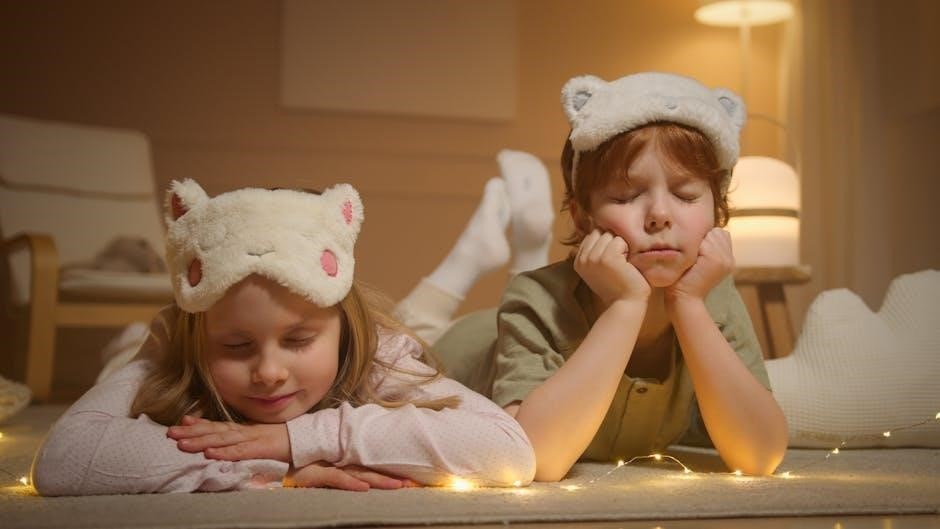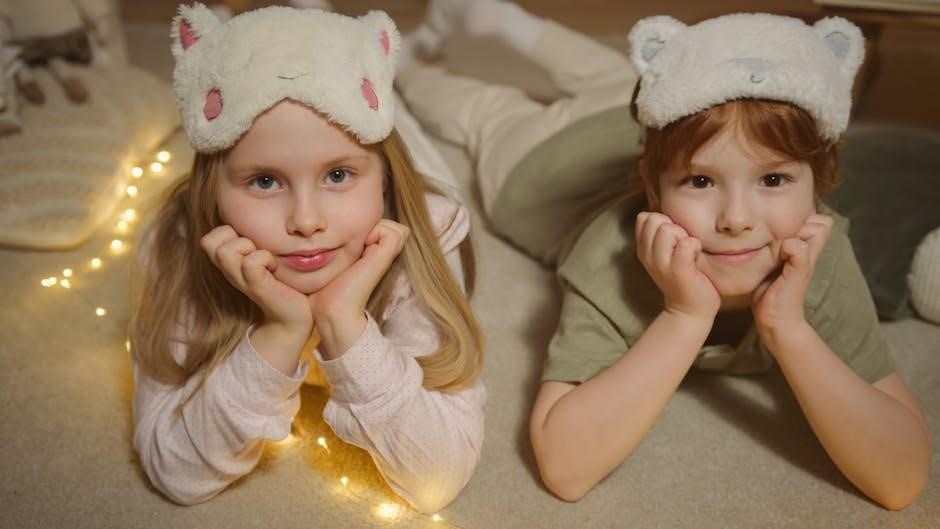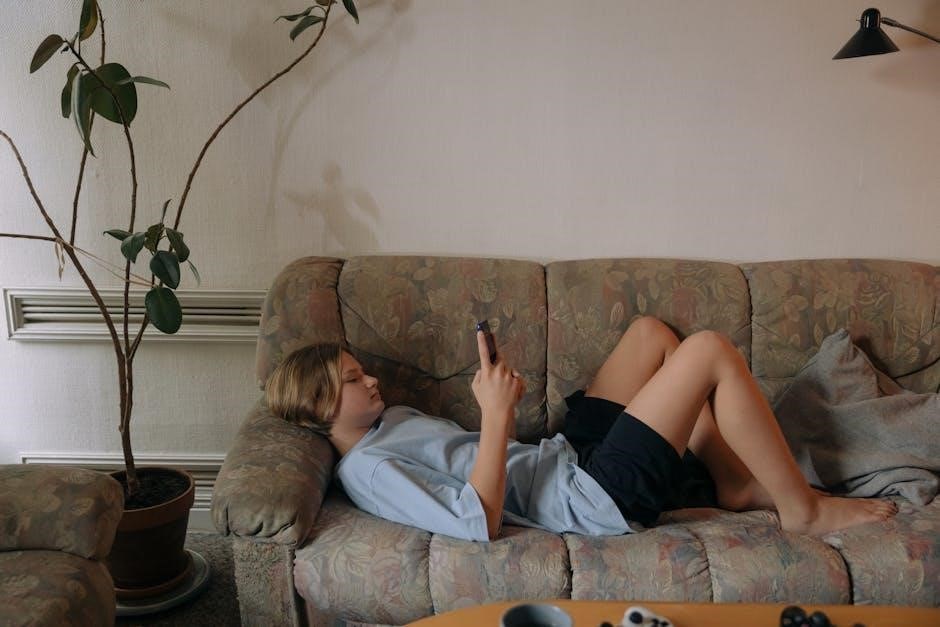
the boy in the striped pajamas pdf
The Boy in the Striped Pajamas‚ by John Boyne‚ is a poignant Holocaust novel available as a PDF for easy access․ Its emotional story of Bruno and Shmuel highlights innocence‚ friendship‚ and tragedy‚ making it a vital educational tool for understanding WWII’s atrocities․
Overview of the Book
The Boy in the Striped Pajamas‚ written by John Boyne‚ is a heart-wrenching Holocaust novel that tells the story of Bruno‚ a young boy whose father becomes a Nazi commandant․ Bruno befriends Shmuel‚ a boy in striped pajamas‚ at a concentration camp‚ leading to a tragic conclusion․ The book explores themes of innocence‚ friendship‚ and the horrors of war․ Available as a PDF‚ it is widely read in schools for Holocaust education‚ offering a powerful narrative that highlights the human cost of WWII and its moral complexities for younger audiences․
Historical Context of the Holocaust
The Holocaust‚ a devastating period during WWII‚ saw the systematic persecution and murder of six million Jews by the Nazi regime․ Concentration camps like Auschwitz‚ central to the story‚ were sites of unimaginable atrocities․ The novel‚ available as a PDF‚ portrays this dark era through Bruno and Shmuel’s friendship‚ highlighting the human cost of war․ It serves as a poignant reminder of the horrors of the Holocaust‚ offering a powerful narrative for educational purposes and historical reflection‚ while emphasizing the importance of understanding this tragic chapter in history․
Author John Boyne and His Inspiration
John Boyne‚ an Irish novelist‚ drew inspiration from Holocaust history to craft The Boy in the Striped Pajamas․ He aimed to humanize the victims through Bruno and Shmuel’s friendship‚ creating an emotional connection for readers․ Boyne’s work‚ available as a PDF‚ reflects his commitment to exploring complex themes like innocence and morality․ His approach to storytelling has made the book a powerful tool for Holocaust education‚ resonating with readers worldwide and fostering deeper understanding of this tragic period in history․

The Plot and Structure of the Book
The story follows Bruno‚ a young boy‚ as he navigates a world torn apart by war and prejudice․ His friendship with Shmuel‚ a boy in striped pajamas‚ unfolds behind a barbed-wire fence‚ symbolizing the harsh realities of Auschwitz․ The novel’s structure builds tension through Bruno’s innocence and curiosity‚ leading to a heart-wrenching conclusion that underscores the horrors of the Holocaust․
Setting: Auschwitz and Its Significance
Auschwitz‚ a notorious Nazi concentration camp‚ serves as the haunting backdrop of the novel․ The barbed-wire fence separating Bruno’s home from the camp symbolizes the harsh divide between innocence and brutality․ The setting underscores the atrocities of the Holocaust‚ with its chilling atmosphere and oppressive regime․ The camp’s presence looms large‚ shaping Bruno’s curiosity and the tragic events that unfold․ Auschwitz’s historical significance as a site of unimaginable suffering adds depth to the story‚ contrasting sharply with Bruno’s naive perspective and the horrifying reality of the Holocaust․
Protagonist Bruno and His Family
Bruno‚ a curious and naive nine-year-old boy‚ is the heart of the story․ Relocated to Auschwitz with his family‚ he struggles to understand his new surroundings․ His father‚ a high-ranking Nazi officer‚ embodies the moral complexity of the regime‚ while Bruno’s mother tries to maintain a sense of normalcy․ Bruno’s sister‚ Gretel‚ grappling with adolescence‚ often finds herself at odds with her brother․ Together‚ they navigate the unsettling reality of their new home‚ unaware of the horrors unfolding just beyond the fence․ Bruno’s family dynamics add emotional depth to the narrative‚ highlighting the personal costs of war․
The Friendship Between Bruno and Shmuel
Bruno and Shmuel form an unlikely friendship across the fence of Auschwitz․ Bruno‚ curious and naive‚ is drawn to Shmuel‚ a boy in striped pajamas‚ who shares his birthday․ Their bond grows despite the barriers‚ with Bruno bringing food and stories․ Shmuel’s wisdom and kindness contrast Bruno’s innocence‚ creating a deep connection․ Their friendship highlights the humanity amidst horror‚ showing loyalty and trust․ Through their interactions‚ Bruno begins to question the reality of the camp‚ while Shmuel finds solace in their bond․ Their friendship is a poignant reminder of hope and innocence in a world torn apart by war․
The Tragic Ending and Its Impact
The novel’s devastating conclusion leaves a lasting emotional impact․ Bruno and Shmuel’s friendship ends in tragedy when Bruno joins Shmuel in the gas chamber‚ unaware of the horrifying fate․ The ending underscores the Holocaust’s atrocities and the loss of innocence․ Readers are left reflecting on the senseless destruction of young lives and the moral complexities of war․ This poignant finale resonates deeply‚ making the story a powerful reminder of humanity’s darkest hours and the importance of remembering history to prevent its repetition․ The ending solidifies the book’s emotional and educational significance․

Themes and Symbolism in the Novel
The novel explores themes of innocence‚ friendship‚ and the horrors of the Holocaust․ Symbols like the fence and uniforms convey the stark contrasts of humanity and oppression․
Innocence and Naivety of Childhood
Bruno’s innocence and naivety are central to the novel‚ as his childlike perspective contrasts sharply with the harsh realities of the Holocaust․ His curiosity and misunderstandings‚ such as referring to the concentration camp as a “farm‚” highlight his lack of awareness․ This innocence makes his friendship with Shmuel poignant‚ as Bruno does not grasp the full horror of their situation․ His naivety serves as a lens through which the atrocities are viewed‚ emphasizing the tragedy of childhood lost to war․ This theme underscores the devastating impact of the Holocaust on the young and innocent․
The Horrors of the Holocaust
The novel vividly portrays the Holocaust’s atrocities through Bruno’s innocent eyes‚ revealing the inhumane conditions and brutal treatment of prisoners․ The concentration camp‚ with its barbed wire and striped uniforms‚ symbolizes oppression and dehumanization․ Bruno’s father‚ a Nazi officer‚ embodies the regime’s ideology‚ while Shmuel’s fate reflects the unimaginable suffering of millions․ The story exposes the moral darkness of the era‚ highlighting the loss of innocence and the devastating consequences of prejudice and hatred․ The PDF version of the book ensures these horrors are remembered and taught to future generations․
Friendship and Loyalty
Bruno and Shmuel’s friendship‚ despite the barbed wire separating them‚ exemplifies loyalty and innocence․ Their bond transcends the horrors of the Holocaust‚ showing how human connections can endure even in the darkest times․ Bruno’s loyalty to Shmuel leads him to make a tragic choice‚ highlighting the strength of their relationship․ The PDF version of the book poignantly captures their story‚ emphasizing how friendship can provide hope amidst despair․ Their loyalty to each other serves as a powerful reminder of humanity’s capacity for love and compassion‚ even in the face of unimaginable evil․
Morality and Guilt in War
The novel explores the moral complexities of war through Bruno’s father‚ a Nazi officer‚ who grapples with his role in the Holocaust․ Bruno’s innocence contrasts sharply with the harsh realities of Auschwitz‚ revealing the moral ambiguities of adulthood․ Guilt permeates the story‚ particularly in Bruno’s father‚ who is torn between duty and conscience․ The PDF version highlights how the characters’ choices reflect the ethical dilemmas of wartime‚ with Bruno’s ultimate sacrifice underscoring the devastating consequences of moral failure․ The book serves as a poignant reminder of the human cost of war and its moral implications․

Characters and Their Roles
Bruno‚ an innocent boy‚ befriends Shmuel‚ a Holocaust victim․ His father‚ a Nazi officer‚ faces moral dilemmas‚ and Gretel struggles with wartime adolescence․
Bruno: The Curious and Innocent Boy
Bruno‚ a curious nine-year-old‚ narrates the story with childlike naivety․ His innocence contrasts the harsh reality of Auschwitz‚ where he befriends Shmuel․ Bruno’s perspective humanizes the Holocaust‚ making its atrocities relatable through his eyes․ His curiosity drives the plot‚ leading to tragic consequences․ The novel highlights Bruno’s journey from innocence to a devastating understanding of the world․ His character serves as a poignant reminder of childhood’s vulnerability in wartime․ The PDF version captures Bruno’s voice effectively‚ engaging readers deeply․
Shmuel: The Boy in Striped Pajamas
Shmuel‚ a Jewish boy in Auschwitz‚ forms a profound friendship with Bruno through the camp fence․ His striped pajamas symbolize the oppression of the Holocaust․ Despite the horrors‚ Shmuel’s resilience and loyalty shine through․ The PDF version vividly portrays his struggles‚ emphasizing his humanity amidst inhumane conditions․ Shmuel’s character serves as a heart-wrenching reminder of the innocent lives lost during the Holocaust‚ making his story unforgettable and deeply impactful for readers of all ages․
Bruno’s Father: A Complex Figure
Bruno’s father‚ a high-ranking Nazi officer‚ embodies the moral ambiguity of the Holocaust․ His role enforces the regime’s brutality‚ yet his paternal instincts create inner conflict․ The PDF version of the novel delves into his character‚ showcasing his influence on Bruno’s naive worldview; His actions drive the story’s tragic trajectory‚ illustrating the harsh realities of war and loyalty․ Bruno’s father is a central‚ complex figure‚ representing the dualities of obedience and humanity‚ making him a poignant and thought-provoking character in the narrative․
Gretel: Bruno’s Sister and Her Struggles
Gretel‚ Bruno’s older sister‚ faces her own challenges in the novel‚ available as a PDF․ Struggling with adolescence and the harsh realities of war‚ she grapples with loyalty to her family and growing doubts about their circumstances․ Her character evolves as she witnesses the horrors of Auschwitz‚ reflecting the moral awakening of youth․ Gretel’s journey from innocence to understanding adds depth to the story‚ highlighting the emotional toll on children during wartime․ Her struggles mirror the broader themes of guilt and morality‚ making her a significant yet often overlooked character․

Literary Style and Narrative Techniques
John Boyne’s third-person limited narrative in The Boy in the Striped Pajamas creates an intimate yet detached tone‚ amplifying the tragic impact․ The PDF version preserves this style‚ ensuring readability and emotional resonance for all readers․
Third-Person Limited Narrative
John Boyne employs a third-person limited narrative in The Boy in the Striped Pajamas‚ focusing solely on Bruno’s perspective․ This technique immerses readers in Bruno’s innocence and naivety‚ amplifying the story’s emotional depth․ The PDF version of the novel maintains this narrative style‚ ensuring the reader experiences the Holocaust through Bruno’s eyes‚ which heightens the tragic contrast between his childhood curiosity and the harsh reality of Auschwitz․ This storytelling method emphasizes the themes of innocence and morality‚ making the narrative both poignant and thought-provoking․
Symbolism of the Fence and Uniforms
In The Boy in the Striped Pajamas‚ the fence separating Bruno and Shmuel symbolizes the physical and emotional barriers between their worlds․ The uniforms‚ particularly the striped pajamas‚ represent the dehumanization of Holocaust victims․ These symbols highlight the stark contrast between innocence and oppression‚ emphasizing the novel’s themes of morality and injustice․ The PDF version of the book retains these powerful symbols‚ allowing readers to reflect on the deeper meanings embedded in the narrative‚ which underscores the tragic reality of the Holocaust and its impact on humanity․
Contrast Between Innocence and Reality
Bruno’s innocence contrasts sharply with the harsh realities of the Holocaust‚ as depicted in The Boy in the Striped Pajamas․ His naive perspective highlights the cruelty of the regime‚ while the PDF version preserves the emotional depth of this contrast․ The friendship between Bruno and Shmuel bridges their worlds‚ revealing the tragic disparity between childhood innocence and the horrors of war․ This contrast underscores the novel’s ability to evoke empathy and reflection‚ making it a powerful tool for understanding the human cost of conflict and oppression․

Historical Accuracy and Criticisms
The PDF version of The Boy in the Striped Pajamas has faced criticism for historical inaccuracies‚ particularly in its portrayal of Auschwitz; While some argue it simplifies complex events‚ Boyne maintains its value as a narrative tool to engage readers emotionally with the Holocaust’s horrors‚ balancing fictional storytelling with historical sensitivity to educate and reflect on the atrocities․
Depiction of Auschwitz and Its Operations
The PDF version of The Boy in the Striped Pajamas portrays Auschwitz with emotional intensity‚ focusing on the camp’s horrors through Bruno’s naive perspective․ While the novel simplifies historical details—such as the impossibility of children meeting through the fence—it captures the atrocities’ essence․ Critics argue that the book overlooks the camp’s industrial-scale operations‚ such as the systematic nature of the Holocaust‚ in favor of a more accessible narrative․ Despite these critiques‚ the story remains a powerful tool for introducing readers to the Holocaust’s brutality‚ balancing historical context with fictional storytelling to evoke empathy and understanding․
Criticisms of Historical Inaccuracies
The PDF version of The Boy in the Striped Pajamas has faced criticism for historical inaccuracies‚ particularly regarding Auschwitz’s depiction․ Critics point out that the fence separating Bruno and Shmuel would not have allowed such close interaction‚ and the boys’ ages are inconsistent with the realities of the camp․ Additionally‚ the novel simplifies the camp’s operations‚ omitting the scale and systematic nature of the Holocaust․ While the story is fictional‚ these inaccuracies have sparked debates about the responsibility of authors to accurately portray historical events‚ even in works meant to educate or evoke emotion․
Boyne’s Response to Criticisms
John Boyne has acknowledged the historical inaccuracies in The Boy in the Striped Pajamas‚ emphasizing that his novel is a work of fiction rather than a historically precise account․ He argues that the story’s emotional core and its ability to engage readers‚ especially younger audiences‚ are more important than strict factual accuracy․ Boyne also highlights the novel’s role in sparking conversations about the Holocaust‚ even if it means sacrificing some historical details․ His response underscores the balance between storytelling and historical education‚ aiming to honor the victims’ memories while making the subject accessible․
Educational Impact and Use in Schools
The Boy in the Striped Pajamas PDF is widely used in classrooms‚ serving as a powerful tool for Holocaust education․ Its accessibility fosters empathy and dialogue among students․

The Book as a Teaching Tool
The Boy in the Striped Pajamas PDF is a valuable resource for educators‚ offering a poignant narrative that engages students emotionally․ Its accessible format allows teachers to integrate Holocaust education seamlessly into curricula․ The story’s themes of innocence‚ friendship‚ and moral complexity encourage critical thinking and empathy․ Schools worldwide use the book to foster discussions on historical atrocities‚ human rights‚ and the impact of war on children․ The PDF version ensures easy distribution‚ making it a practical tool for classrooms․ Its inclusion in educational programs underscores its role in promoting Holocaust awareness and ethical reflection among young learners․
Discussions on Holocaust Education
The Boy in the Striped Pajamas PDF sparks essential discussions on Holocaust education‚ encouraging students to reflect on historical atrocities․ The story’s emotional depth fosters empathy‚ helping learners grasp the human impact of WWII․ Educators use the book to explore themes like innocence‚ friendship‚ and moral dilemmas‚ creating a safe space for dialogue․ Its accessibility in digital formats ensures wider reach‚ making it a key resource for teaching Holocaust awareness and promoting tolerance․ These discussions are crucial for understanding history and preventing future injustices‚ enriching students’ perspectives on humanity and ethics․
Controversies in the Classroom
The Boy in the Striped Pajamas PDF has sparked debates in educational settings due to its portrayal of the Holocaust․ While some educators praise its ability to engage students‚ others criticize its historical inaccuracies and emotional impact․ Concerns arise about whether the novel oversimplifies the atrocities‚ potentially misleading young readers․ Additionally‚ discussions about its suitability for certain age groups continue‚ as the book tackles mature themes; These controversies highlight the challenges of teaching Holocaust literature‚ balancing empathy with factual accuracy to ensure students grasp the gravity of history without being overwhelmed by its horrors․
Sequel and Related Works
John Boyne’s All the Broken Places serves as a sequel to The Boy in the Striped Pajamas‚ continuing Bruno’s story and exploring unresolved emotions‚ available as a PDF․
“All the Broken Places” as a Sequel
John Boyne’s All the Broken Places serves as a poignant sequel to The Boy in the Striped Pajamas‚ revisiting Bruno’s story decades later․ The novel ties up loose ends‚ exploring unresolved emotions and the lasting impact of Bruno’s experiences․ Available as a PDF‚ it offers a deeply emotional journey‚ delving into themes of guilt‚ reconciliation‚ and the haunting memories of the Holocaust․ This sequel provides closure while expanding the narrative‚ making it a compelling companion to the original book for readers seeking deeper insight․
Gretel’s Story and Its Significance
Gretel‚ Bruno’s sister‚ plays a pivotal role in The Boy in the Striped Pajamas‚ struggling with her own morality amid the Holocaust․ Her story‚ explored in depth in John Boyne’s works‚ reflects the internal conflicts of youth during wartime․ Available as a PDF‚ Gretel’s narrative offers a unique perspective on the emotional toll of war on families․ Her character symbolizes the duality of innocence and complicity‚ adding layers to the novel’s exploration of human complexity and ethical dilemmas․ Gretel’s journey underscores the lasting impact of historical events on individuals and their identities․
Boyne’s Other Works on the Holocaust
John Boyne’s literary contributions extend beyond The Boy in the Striped Pajamas‚ with works like All the Broken Places continuing to explore Holocaust themes․ These novels‚ available as PDFs‚ delve into the emotional and psychological aftermath of the Holocaust․ Boyne’s writing often focuses on the human condition‚ offering profound insights into the ethical and moral dilemmas faced during and after WWII․ His works serve as essential tools for Holocaust education‚ providing readers with a deeper understanding of its historical and personal impact․ Boyne’s dedication to this subject ensures his novels remain relevant and impactful․

Adaptations and Media
The 2008 film adaptation of The Boy in the Striped Pajamas brought the story to life‚ capturing its emotional depth․ Inspired by the book‚ other media formats‚ including stage plays and digital adaptations‚ have further expanded its reach‚ ensuring its powerful message resonates across generations․
The 2008 Film Adaptation
The 2008 film adaptation of The Boy in the Striped Pajamas‚ directed by Mark Herman‚ brought John Boyne’s novel to the screen․ Starring Asa Butterfield as Bruno and Jack Scanlon as Shmuel‚ the movie captures the heart-wrenching story of friendship and tragedy․ It received critical acclaim for its emotional depth and authenticity‚ though some historians noted inaccuracies․ The film remains a powerful visual representation of the novel‚ enhancing its global impact and aligning with the book’s themes of innocence and the Holocaust’s horrors‚ making it a significant companion to the PDF version․
Reception of the Movie
The 2008 film adaptation of The Boy in the Striped Pajamas received widespread critical acclaim for its emotional depth and poignant portrayal of friendship amidst tragedy․ Audiences and critics praised its ability to convey the horrors of the Holocaust through a child’s perspective․ However‚ some historians criticized the film for historical inaccuracies‚ particularly in its depiction of Auschwitz․ Despite this‚ the movie remains a powerful visual companion to the novel and its PDF version‚ enhancing the story’s global impact and sparking important discussions about its themes and historical context․
Other Media Inspired by the Book
Beyond the novel and its PDF version‚ The Boy in the Striped Pajamas has inspired various forms of media‚ including stage plays‚ educational resources‚ and even audio adaptations․ These interpretations aim to preserve the story’s emotional impact while reaching diverse audiences․ The book’s themes of innocence and friendship continue to resonate‚ making it a source of inspiration for creative works that honor its legacy and educate future generations about the Holocaust․ Its influence extends beyond literature‚ ensuring its message endures in multiple formats․

Availability and Downloads

PDF versions of The Boy in the Striped Pajamas are widely available for download on ebook platforms․ Ensure purchases are from legal sources to avoid pirated copies and support authors․
PDF Versions and Digital Copies
The Boy in the Striped Pajamas is widely available in PDF format‚ accessible through platforms like Rak Buku Digital and educational websites․ Readers can download the novel legally from authorized ebook retailers‚ ensuring support for the author and publisher․ Digital copies are convenient for students and educators‚ facilitating easy access for Holocaust education and personal reading․ The PDF version maintains the original narrative’s emotional depth and historical significance‚ making it a popular choice for both academic and casual readers worldwide․
Legal and Ethical Considerations
Accessing The Boy in the Striped Pajamas as a PDF requires adherence to copyright laws․ Downloading from unauthorized sites is illegal and undermines authors’ rights․ Purchasing from reputable retailers like Penguin Random House ensures ethical support for creators․ Schools and educators often provide legal access through digital libraries․ Respecting intellectual property is crucial‚ especially for works addressing sensitive historical topics like the Holocaust‚ ensuring the book’s message remains accessible and respected for educational purposes․
Where to Find the Book Legally
The Boy in the Striped Pajamas PDF can be legally obtained through reputable retailers like Penguin Random House‚ Amazon‚ or Rak Buku Digital․ Many libraries and educational platforms also offer digital copies for borrowing․ Additionally‚ schools often provide access through their databases․ Purchasing directly from the publisher or authorized sellers ensures support for the author and compliance with copyright laws․ Always avoid unauthorized sites to respect intellectual property and maintain ethical access to this important Holocaust narrative․
The Boy in the Striped Pajamas remains a powerful Holocaust narrative‚ with its PDF version widely accessible for educational purposes‚ ensuring its legacy endures as a vital historical resource․
Legacy of the Book
The Boy in the Striped Pajamas has left an indelible mark on Holocaust literature․ Its PDF availability ensures accessibility‚ educating new generations about WWII atrocities․ The story’s emotional depth and historical significance make it a crucial tool for understanding the Holocaust’s impact․ John Boyne’s masterpiece continues to resonate globally‚ fostering empathy and awareness․ Its legacy is cemented through its widespread use in education and its ability to provoke meaningful discussions about humanity and morality during one of history’s darkest periods․
Impact on Readers and Education
The Boy in the Striped Pajamas profoundly impacts readers by offering a child’s perspective on the Holocaust‚ making it relatable and poignant․ Its PDF format ensures accessibility‚ aiding educators in integrating it into curricula․ The novel fosters empathy and understanding‚ encouraging discussions on tolerance and human rights․ As a teaching tool‚ it bridges historical events with personal narratives‚ enriching Holocaust education and leaving a lasting impression on students and readers worldwide‚ promoting reflection on morality and compassion․
Final Thoughts on the Novel’s Importance
The Boy in the Striped Pajamas remains a crucial piece of Holocaust literature‚ offering a unique perspective through its PDF availability․ Its ability to engage readers emotionally while educating them about historical atrocities ensures its lasting relevance․ The novel’s themes of innocence‚ friendship‚ and morality resonate deeply‚ making it a powerful tool for fostering empathy and understanding․ As a widely accessible resource‚ it continues to influence education and personal reflection‚ solidifying its place as an essential read for generations seeking to comprehend the Holocaust’s profound impact․